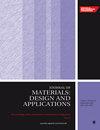Selected properties of X120Mn12 steel welded joints by means of the plasma-MAG hybrid method
IF 2.5
4区 材料科学
Q3 MATERIALS SCIENCE, MULTIDISCIPLINARY
Proceedings of the Institution of Mechanical Engineers, Part L: Journal of Materials: Design and Applications
Pub Date : 2024-05-21
DOI:10.1177/14644207241256113
引用次数: 0
Abstract
The article describes properties of welds made of high wear resistance X120Mn12 steel obtained by the hybrid PTA-MAG (plasma transferred arc – metal active gas) method. The specimens were 8 mm thick rectangular (200 mm × 350 mm) sheets metal. The analyzed butt welds were made with the parameters selected according to the criterion of smallest cross-sectional area of welds and the narrowest HAZ (heat affected zone). The outcome of metallographic tests of weld, HAZ and parent material, hardness distribution and XRD (X-ray diffraction) patterns of selected areas are presented. The IIT (Instrumented Indentation Test) method was used to describe the distribution of mechanical properties shaped by thermal cycle annealing of the welding process. The investigation shows that the application of the PTA-MAG hybrid heat source for welding manganese steel enables the use of the filler material ER307 (AWS-A5.9). The hybrid PTA-MAG welding system has the relatively high potential to be an efficient alternative to welding standard processes for X120Mn12 steel due to the HAZ overheating limitation. The zone of high-risk weld cracking is the part of the HAZ close to the fusion area that has been reheated during weldment formation. Heat input about 0.6 kJ/mm is needed to provide full deep penetration butt weld without defects and with a vapor capillary of wide enough to cover the weld gap. The increase of hardness in the welded joint is smooth distributed and going up to 10% compared to the base material. The width of HAZ was <1 mm. Intensive carbides precipitation in HAZ has been avoided successfully.等离子-MAG 混合法 X120Mn12 钢焊接接头的部分特性
文章介绍了采用混合 PTA-MAG(等离子体转移电弧-金属活性气体)方法获得的高耐磨性 X120Mn12 钢焊缝的性能。试样为 8 毫米厚的矩形(200 毫米 × 350 毫米)金属板。所分析的对接焊缝的参数是根据焊缝横截面积最小和热影响区(HAZ)最窄的标准选择的。文中介绍了焊缝、热影响区和母材的金相测试结果、硬度分布以及选定区域的 XRD(X 射线衍射)图样。IIT(仪器压痕测试)方法用于描述焊接过程中热循环退火所形成的机械性能分布。研究表明,在锰钢焊接中应用 PTA-MAG 混合热源可以使用填充材料 ER307(AWS-A5.9)。由于热影响区过热限制,PTA-MAG 混合焊接系统具有相对较高的潜力,可有效替代 X120Mn12 钢的标准焊接工艺。焊接裂纹的高风险区是靠近熔合区的 HAZ 部分,该部分在焊接形成过程中被重新加热。需要输入约 0.6 kJ/mm 的热量,才能形成无缺陷的全深穿透对接焊缝,且蒸汽毛细管的宽度足以覆盖焊缝间隙。与母材相比,焊点硬度的增加分布平稳,最高可达 10%。HAZ 的宽度小于 1 毫米。成功避免了 HAZ 中碳化物的大量析出。
本文章由计算机程序翻译,如有差异,请以英文原文为准。
求助全文
约1分钟内获得全文
求助全文
来源期刊

CiteScore
4.70
自引率
8.30%
发文量
166
审稿时长
3 months
期刊介绍:
The Journal of Materials: Design and Applications covers the usage and design of materials for application in an engineering context. The materials covered include metals, ceramics, and composites, as well as engineering polymers.
"The Journal of Materials Design and Applications is dedicated to publishing papers of the highest quality, in a timely fashion, covering a variety of important areas in materials technology. The Journal''s publishers have a wealth of publishing expertise and ensure that authors are given exemplary service. Every attention is given to publishing the papers as quickly as possible. The Journal has an excellent international reputation, with a corresponding international Editorial Board from a large number of different materials areas and disciplines advising the Editor." Professor Bill Banks - University of Strathclyde, UK
This journal is a member of the Committee on Publication Ethics (COPE).
 求助内容:
求助内容: 应助结果提醒方式:
应助结果提醒方式:


